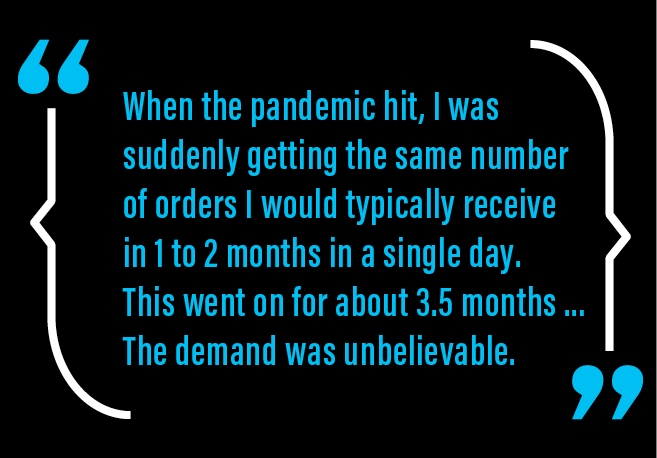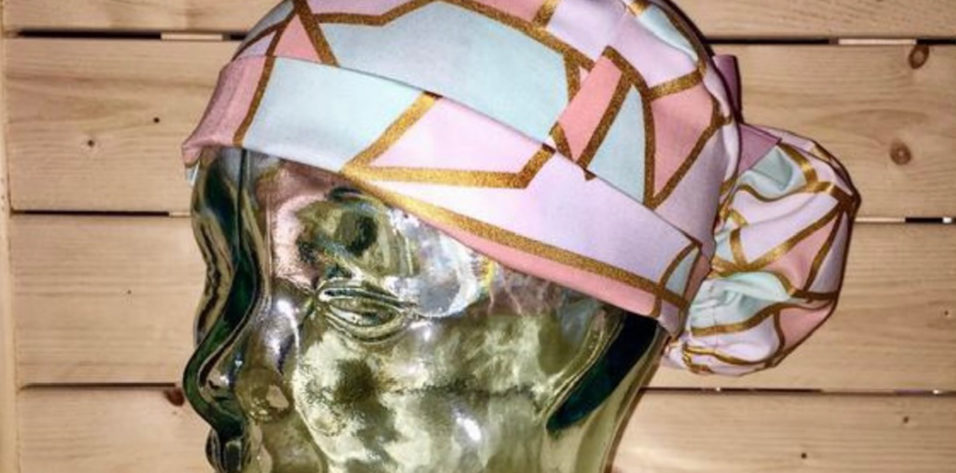Prior to the COVID-19 pandemic, Caroline Watson, MD, was a busy ophthalmology resident with a steady side business selling handmade scrub hats from her Etsy shop, BlackberryVineCo. Once the pandemic hit and health care professionals desperately needed personal protective equipment (PPE), Dr. Watson found herself at home and having to adapt to an unprecedented surge in demand for her scrub hats.
Please tell us a bit about yourself.
I am currently starting an advanced anterior segment fellowship at The Eye Institute of West Florida in Clearwater, Florida. My family and I live in Slidell, Louisiana, located 30 miles north of New Orleans. This is where I grew up. My husband and I have been married for 13 years, and we have three children. We try to spend our free time on the water, fishing, waterskiing, or playing on a nearby beach; although, with three kids, we don’t have much free time at the moment!
When did you first begin sewing?
I learned to sew at a young age, around 8 years old. My mother used to bring me and my sister to my Great Aunt Linda’s house in the summer for a few hours a week. This is where she would teach us how to sew. I have no idea why she did this, but, in retrospect, I’m glad she had the foresight to recognize that sewing was a skill that not many members of my generation would have the opportunity to learn.
What prompted you to start making scrub hats, and how did that lead to opening your Etsy store?
As I made my way through medical school, I started noticing medical professionals wearing surgical caps made of cotton fabric. I completed a visiting rotation at Emory University at the end of my third year of medical school, and while there, I spent a lot of time around the OR and in the big hospitals in Atlanta. I kept seeing these fabric scrub hats on the nurses, residents, and attendings and thinking, “Wow, those are ugly! I can make better ones.” One night when I was talking to my sister about the hats, she said, “You should start an Etsy store and just make scrub hats yourself.” Toward the end of my rotation, I decided to go to a local fabric store. I purchased a few fabrics and started working on a pattern for a scrub hat. After some trial and error, I decided on a pattern and made my first hat. The pattern and materials have developed over time into what I now sell in my Etsy store. Although mostly unplanned, I felt encouraged by my sister to turn this project into a profitable business.
How do you find time to fit in sewing and running a business as a training ophthalmologist?
When I first started getting orders in 2016, I made all the hats myself at night, after I got home from the hospital. It took up a lot of my time. I distinctly remember being an intern and seeing all the residents take these lavish trips; there I was taking a vacation week to catch up on orders and sew scrub hats! As business increased, a sweet lady who lived down the street from me began helping me sew. She would cut the fabric and get the hats started, and I would finish the sewing, package them, and bring them to the post office the next day. To this day, she continues to sew for me and says she really enjoys it.
When I moved back to Louisiana to begin residency, a life-long family friend started helping me sew. Even though we were splitting the workload, there was still a lot of sewing to do on a daily basis. At the beginning of my third year of residency, I found another person to sew for me, which further lightened the load. After that, the process became much smoother—that was the first year in which I only sewed a handful of hats during the holiday season. Currently, four people sew for me full time. My husband also helps a lot with the business. He can do every part except sew a hat together. He can cut the patterns out of fabric, cut ribbon, package the hats, run fabric to whoever needs it, etc. As my business has continued to grow, I have found more help and now have a smooth and efficient process that allows me to be very hands-off.

How did the onset of the COVID-19 pandemic affect daily life for you and your family?
When the pandemic started, I was 3.5 hours from home on a 10-week rotation. I like to go on this block at this time of year because it gives me the ability to study for the yearly Ophthalmic Knowledge Assessment Program exam without the distractions I have at home. My site director started cutting clinic, and, as cases spread, most of our clinics were put on hold due to the lockdown in Louisiana. My husband started working from home, and our kids were sent home from school and daycare. As a result, we both took on the role of teacher for a fifth grader and a kindergartner. It was daunting for us to go from working our professional jobs to being stay-at-home parents and the sole providers of our children’s education. However, we switched modes from ophthalmologist and aerospace engineer to teachers and hat makers. We were cutting, sewing, and running fabric back and forth to three different cities in Louisiana where my other employees lived while orchestrating the entire business from my cell phone.
How did the onset of the pandemic affect your business?
I distinctly remember having a conversation with my now fellowship director in February 2020. He knew about my business and called to ask if my store was “going crazy.” I hadn’t noticed any change at that point, but he had the insight to understand that the pandemic would affect the availability of PPE and that my little business could be affected. Before COVID-19, I had just entered my fifth year of business, which had seen a steady growth of approximately 30% each year from the start. When the pandemic hit, I was suddenly getting the same number of orders I would typically receive in 1 to 2 months in a single day. This trend lasted for about 3.5 months and then slowly tapered down to a new baseline number of orders. The demand was unbelievable. I felt so badly for the frontline health care workers. Here I was, sent home from my rotation and making hats day and night. Other Etsy stores that had been established for as long as mine or longer were closing. They just couldn’t keep up with the demand. I felt like the last man standing, and it was an unbelievable experience. My store’s production went up about 1,300% in 1 week.
How did you adapt your business to keep up with changing demand?
The first week we had this exponential increase in demand, I was unprepared. Orders went from a consistent trickle to a never-ending stream in a matter of days. Once we had this exponential growth, I immediately started recruiting people to sew. I hired 10 people in a 2-week period, all of whom had been sent home from their jobs or lost their jobs. We started cranking out hats. People who know how to sew well don’t need much instruction to make something simple, and they usually enjoy doing so—it’s a bonus to get paid to do it from the comfort of home. That is most likely why this system actually worked.
To add insult to injury, one of my main fabric suppliers closed its doors indefinitely 3 weeks into the pandemic, so I quickly bought fabric in bulk multiple times to ensure that I had enough. I started realizing that every item I needed to run my business was becoming scarce. Fabric manufacturers shut down, elastic became impossible to find, and ribbon production decreased. Thread, shipping supplies, and paper all became scarce. It was unlike anything I had ever seen. Luckily, by that point, I had been toying with the idea of buying from a wholesale fabric manufacturer. I finally bit the bullet and purchased several new, well-made fabrics to provide hats for my customers.
What does your business look like today? How has it changed since last year?
My business has a higher baseline of sales today compared to before the pandemic. I believe that this may be due to the demand for PPE extending to other areas of the health care field. For example, I recently went to the dentist and saw my dental hygienist wearing a scrub cap for the first time. Now, it’s not only surgeons and OR staff wearing scrub hats to protect themselves but also floor nurses, ICU staff, emergency department staff, etc.
You have been able to supply health care workers with PPE when they needed it most and provide work for others during a time of financial hardships. What has the experience felt like for you? What has been the response from your customers and employees?
Overall, this has been a wonderful learning experience from a business standpoint. I was able to catch a glimpse into what it’s like to run a big business, and I like to think it was a peek into what my business could eventually become. During the height of the pandemic, most customers were extremely grateful, and the messages they left me were heartbreaking. People were begging for fabric scrub hats, saying they were wearing the same paper hats for a week straight or that they had nothing to wear to protect themselves. Their fear, stress, and exhaustion were apparent. We did our best to keep up with the demand, but our production times obviously had to be extended. I even hired my coresident to manage the store’s message board because so many messages were coming in all day, every day.
Of course, I sometimes felt guilty that my income was growing while others were struggling. However, this feeling left near the end of summer, after a conversation with a woman who worked for me. She and her husband had owned an air conditioning business for more than 30 years, and it was suffering. She told me that her sewing job had saved them financially, and she didn’t know what she would have done without it. I felt so relieved knowing that I could provide that safety net for them. Other employees also expressed feeling grateful to have the income at a time when they didn’t have other employment or extra money. Two of my employees were teachers at my children’s school and decided not to return this past fall and to instead sew for me full time. My aunt, who was in her last year of teaching, stepped in to help cut fabric for all the people sewing, which helped to smooth out the production process. It’s rewarding to be able to provide jobs for people who don’t feel safe leaving their homes.
What advice do you have for other young ophthalmologists who are interested in pursuing a side hustle?
Start slow, and don’t procrastinate! Additionally, businesses take time to develop. Don’t give up after a few months. You have to learn to change, adapt, and understand what people like and want. It’s also important to be good at multitasking. I tend to thrive when I’m busy with a lot of different tasks, so having something to do besides practicing ophthalmology helps my mental wellbeing. Plus, I always have a cute scrub hat to wear!


